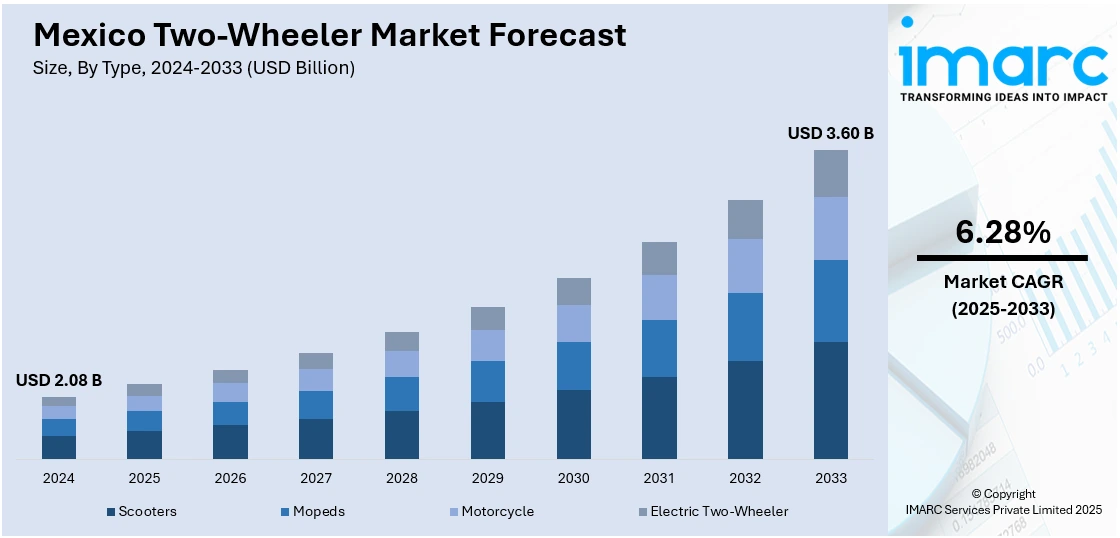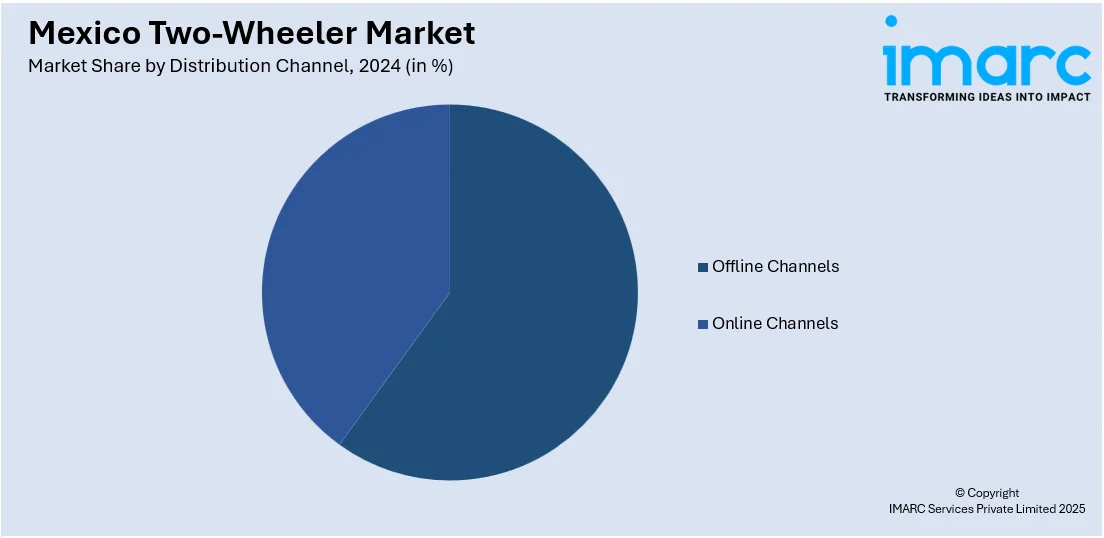
Mexico Two-Wheeler Market Size, Share, Trends and Forecast by Type, Technology, Transmission, Engine Capacity, Fuel Type, Distribution Channel, End User, and Region, 2025-2033
Mexico Two-Wheeler Market Overview:
The Mexico two-wheeler market size reached USD 2.08 Billion in 2024. Looking forward, IMARC Group expects the market to reach USD 3.60 Billion by 2033, exhibiting a growth rate (CAGR) of 6.28% during 2025-2033. The market is propelled by factors such as rising urbanization, increasing traffic congestion, and a growing demand for affordable personal transportation, leading to a surge in motorcycle sales. Additionally, the emergence of electric models, government incentives, and the dominance of local manufacturers are reshaping the market landscape.
|
Report Attribute
|
Key Statistics
|
|---|---|
|
Base Year
|
2024
|
|
Forecast Years
|
2025-2033
|
|
Historical Years
|
2019-2024
|
| Market Size in 2024 | USD 2.08 Billion |
| Market Forecast in 2033 | USD 3.60 Billion |
| Market Growth Rate 2025-2033 | 6.28% |
Mexico Two-Wheeler Market Trends:
Increased Adoption of Electric Two-Wheelers
Mexico is experiencing a steady rise in the adoption of electric two-wheelers based on heightened environmental awareness and friendly public policies to mitigate urban air pollution. Consumers in urban locations are highly choosing electric versions because of their reduced operational expenses and maintenance ease relative to internal combustion engine variants. Increased development of better battery technologies and investment in charging infrastructure are also supporting this transition. Moreover, urban mobility patterns are conducive to smaller, greener vehicles that can comfortably navigate through congested city streets. With electric variants becoming more affordable in terms of price as well as performance, their proportion within the overall two-wheeler segment is boosting incrementally. Mexico two-wheeler market outlook sees a significant increase in the share of the electric segment, commensurate with global trends towards sustainability and urban development objectives. For instance, in September 2024, Yadea launched the Kemper electric motorcycle in Mexico, boasting advanced CATL battery technology, a top speed of 160 km/h, 0–100 km/h acceleration in 4.9 seconds, and an 80% charge in just 10 minutes. Moreover, this trend reflects a wider trend towards more eco-friendly modes of transportation, implying long-term potential for growth among electric two-wheelers in urban as well as semi-urban areas.

Urban Commuting Preferences Growth
Urban development and traffic congestion have had a very major impact on mobility choices in Mexico, and the usage of two-wheelers for daily travel has increased noticeably. Students and young professionals are particularly attracted to scooters and light motorcycles due to their cost-effectiveness, fuel economy, and ease of navigation through tight traffic. With cities expanding and parking areas becoming tighter and tighter, two-wheelers are a sensible choice over conventional vehicles. The amplifying number of users of delivery and personal mobility has also driven this trend. Government efforts in urban infrastructure and road safety enhancements are supplementing this trend by improving safety and convenience of two-wheeler use. As per the sources, in January 2025, cyclists in the State of Mexico shall be obligated to go through the process of obtaining certification, taking both theoretical and practical tests in order to apply for a driver's license and strengthen road security as well as limit accidents. Furthermore, the Mexico two-wheeler market share in urban transportation keeps growing, reflecting larger consumer behavior trends that prefer speed and efficiency. This urban-centric growth is expected to play a pivotal role in shaping the future trajectory of the two-wheeler industry, particularly as population density and commuting needs evolve in major metropolitan regions.
Growing Two-Wheeler Penetration in Semi-Urban Markets
While cities have long been the drivers of vehicle sales in Mexico, demand is increasingly shifting toward semi-urban and rural markets. Two-wheelers are being intensely used as primary means of transportation in these regions because of their cost effectiveness, low cost of maintenance, and capacity to traverse relatively underdeveloped roads. The adaptability of motorcycles and mopeds is suitable for multiple purposes, such as personal travel, agricultural assistance, and local business. Infrastructure expansion and greater ease of access to credit facilities are also helping residents of these regions to buy two-wheelers more conveniently. With this adoption spreading further, the Mexican two-wheeler market growth trend is being sustained by the expanding geographic footprint of demand. This realignment identifies the size potential beyond city centers and portends a sustainable pattern of enhanced motorization in rural areas. Suppliers and government authorities are also now realizing this prospect, and this should weigh upon product planning for the future as well as mobility planning across regions.
Mexico Two-Wheeler Market Segmentation:
IMARC Group provides an analysis of the key trends in each segment of the market, along with forecasts at the region level for 2025-2033. Our report has categorized the market based on type, technology, transmission, engine capacity, fuel type, distribution channel, and end user.
Type Insights:
- Scooters
- Mopeds
- Motorcycle
- Electric Two-Wheeler
A detailed breakup and analysis of the market based on the transmission have also been provided in the report. This includes scooters, mopeds, motorcycle, and electric two-wheeler.
Technology Insights:
- ICE
- Electric
The report has provided a detailed breakup and analysis of the market based on the technology. This includes ICE and electric.
Transmission Insights:
- Manual
- Automatic
A detailed breakup and analysis of the market based on the transmission have also been provided in the report. This includes manual and automatic.
Engine Capacity Insights:
- <100cc
- 100-125cc
- 126-180cc
- 181-250cc
- 251-500cc
- 501-800cc
- 801-1600cc
- >1600cc
The report has provided a detailed breakup and analysis of the market based on the engine capacity. This includes <100cc, 100-125cc, 126-180cc, 181-250cc, 251-500cc, 501-800cc, 801-1600cc, and >1600cc.
Fuel Type Insights:
- Gasoline
- Petrol
- Diesel
- LPG/CNG
- Battery
A detailed breakup and analysis of the market based on the fuel type have also been provided in the report. This includes gasoline, petrol, diesel, LPG/CNG, and battery.
Distribution Channel Insights:

- Offline Channels
- Online Channels
The report has provided a detailed breakup and analysis of the market based on the distribution channel. This includes offline channels and online channels.
End User Insights:
- Personal
- Commercial
A detailed breakup and analysis of the market based on the end user have also been provided in the report. This includes personal and commercial.
Regional Insights:
- Northern Mexico
- Central Mexico
- Southern Mexico
- Others
The report has also provided a comprehensive analysis of all the major regional markets, which include Northern Mexico, Central Mexico, Southern Mexico, and others.
Competitive Landscape:
The market research report has also provided a comprehensive analysis of the competitive landscape. Competitive analysis such as market structure, key player positioning, top winning strategies, competitive dashboard, and company evaluation quadrant has been covered in the report. Also, detailed profiles of all major companies have been provided.
Mexico Two-Wheeler Market News:
- In November 2024, Honda Mexico launched three new vehicles: the TRX250X ATV for ultimate versatility, the high-performance TRX700, and the CB650R with an E-Clutch for better riding. The models, launched come with cutting-edge technologies, strong builds, and upgraded features for an exhilarating experience.
Mexico Two-Wheeler Market Report Coverage:
| Report Features | Details |
|---|---|
| Base Year of the Analysis | 2024 |
| Historical Period | 2019-2024 |
| Forecast Period | 2025-2033 |
| Units | Billion USD |
| Scope of the Report |
Exploration of Historical Trends and Market Outlook, Industry Catalysts and Challenges, Segment-Wise Historical and Future Market Assessment:
|
| Types Covered | Scooters, Mopeds, Motorcycle, Electric Two-Wheeler |
| Technologies Covered | ICE, Electric |
| Transmissions Covered | Manual, Automatic |
| Engine Capacities Covered | <100cc, 100-125cc, 126-180cc, 181-250cc, 251-500cc, 501-800cc, 801-1600cc, >1600cc |
| Fuel Types Covered | Gasoline, Petrol, Diesel, LPG/CNG, Battery |
| Distribution Channels Covered | Offline Channels, Online Channels |
| End Users Covered | Personal, Commercial |
| Regions Covered | Northern Mexico, Central Mexico, Southern Mexico, Others |
| Customization Scope | 10% Free Customization |
| Post-Sale Analyst Support | 10-12 Weeks |
| Delivery Format | PDF and Excel through Email (We can also provide the editable version of the report in PPT/Word format on special request) |
Key Questions Answered in This Report:
- How has the Mexico two-wheeler market performed so far and how will it perform in the coming years?
- What is the breakup of the Mexico two-wheeler market on the basis of type?
- What is the breakup of the Mexico two-wheeler market on the basis of technology?
- What is the breakup of the Mexico two-wheeler market on the basis of transmission?
- What is the breakup of the Mexico two-wheeler market on the basis of engine capacity?
- What is the breakup of the Mexico two-wheeler market on the basis of fuel type?
- What is the breakup of the Mexico two-wheeler market on the basis of distribution channel?
- What is the breakup of the Mexico two-wheeler market on the basis of end user?
- What is the breakup of the Mexico two-wheeler market on the basis of region?
- What are the various stages in the value chain of the Mexico two-wheeler market?
- What are the key driving factors and challenges in the Mexico two-wheeler?
- What is the structure of the Mexico two-wheeler market and who are the key players?
- What is the degree of competition in the Mexico two-wheeler market?
Key Benefits for Stakeholders:
- IMARC’s industry report offers a comprehensive quantitative analysis of various market segments, historical and current market trends, market forecasts, and dynamics of the Mexico two-wheeler market from 2019-2033.
- The research report provides the latest information on the market drivers, challenges, and opportunities in the Mexico two-wheeler market.
- Porter's five forces analysis assist stakeholders in assessing the impact of new entrants, competitive rivalry, supplier power, buyer power, and the threat of substitution. It helps stakeholders to analyze the level of competition within the Mexico two-wheeler industry and its attractiveness.
- Competitive landscape allows stakeholders to understand their competitive environment and provides an insight into the current positions of key players in the market.
Need more help?
- Speak to our experienced analysts for insights on the current market scenarios.
- Include additional segments and countries to customize the report as per your requirement.
- Gain an unparalleled competitive advantage in your domain by understanding how to utilize the report and positively impacting your operations and revenue.
- For further assistance, please connect with our analysts.
 Request Customization
Request Customization
 Speak to an Analyst
Speak to an Analyst
 Request Brochure
Request Brochure
 Inquire Before Buying
Inquire Before Buying




.webp)




.webp)












